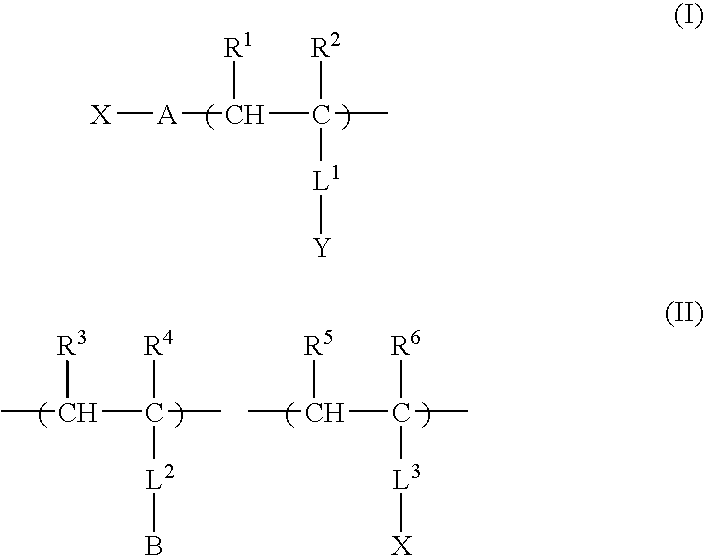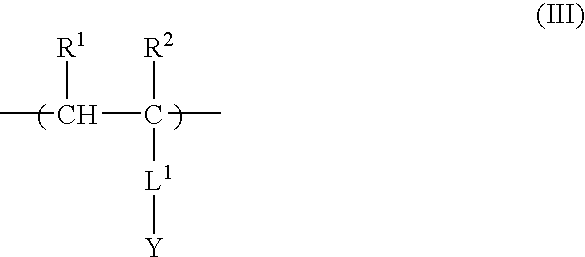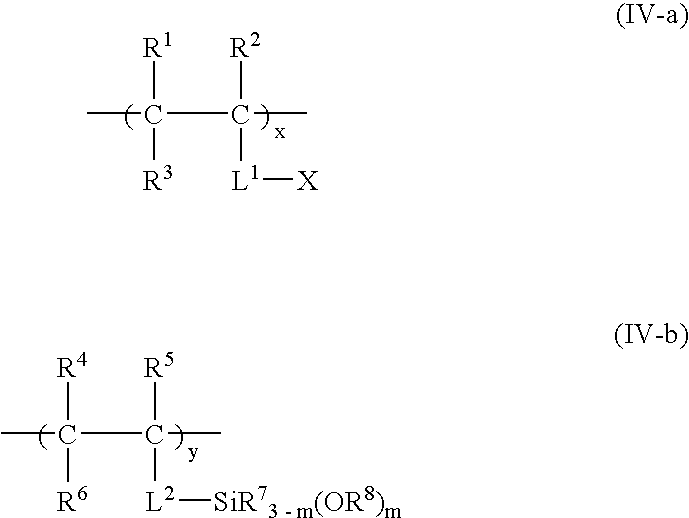Hydrophilic member and undercoating composition
a technology of water droplets and hydrophilic components, which is applied in the direction of coatings, transportation and packaging, chemical instruments and processes, etc., can solve the problems of insufficient anti-fouling properties against the adhesion of water droplets, inability to easily remove, and irregular reflection of light, etc., to achieve excellent hydrophilicity, anti-abrasion properties, anti-fouling properties, anti-abrasion properties, anti-fogging properties
- Summary
- Abstract
- Description
- Claims
- Application Information
AI Technical Summary
Benefits of technology
Problems solved by technology
Method used
Image
Examples
example 1
[0223]A polyethylene terephthalate (PET) substrate (thickness: 50 μm), a surface of which had been hydrophilized by a glow treatment, was prepared; and a first layer coating solution (1) having the following composition was spin coated thereon (at 1,000 rpm for 30 seconds) and dried in an oven at 100° C. for 2 minutes to form a first layer at a dry coverage of 0.5 g / m2. The first layer had a water droplet contact angle of 80 degrees. Subsequently, a hydrophilic layer coating solution (1) was spin coated on the first layer (at 100 rpm for 2 minutes, at 50 rpm for 5 minutes and then at 200 rpm for 2 minutes) and dried in an oven at 100° C. for 10 minutes to form a hydrophilic layer at a dry coverage of 2.0 g / m2, thereby preparing a hydrophilic member. The coating surface properties were satisfactory. This hydrophilic member had a water droplet contact angle of not more than 5 degrees and surface free energy of 87 mN / m and had a surface with very high hydrophilicity. The hydrophilic la...
example 2
[0247]A first layer coating solution (2) having the following composition was spin coated on the first layer as described in Example 1 (at 1,000 rpm for 60 seconds) and dried in an oven at 100° C. for 10 minutes to form a layer at a dry coverage of 0.5 g / m2, thereby forming a first layer of a two-layered structure. The layer formed from the first layer coating solution (2) had a water droplet contact angle of 10 degrees. Subsequently, a hydrophilic layer was prepared on this first layer of a two-layered structure in the same manner as in Example 1. The obtained hydrophilic member had the same performance as that in Example 1 with respect to hydrophilicity, water resistance, anti-abrasion properties, scratch resistance, anti-fogging properties, antifouling properties, visible light transmittance and weather resistance. The results are shown in Table 1.
[0248]The member was obliquely cut to prepare a cross-section sample and subjected to TOF-SIMS analysis. As a result, a urethane linka...
examples 3 to 4
[0251]Hydrophilic layers were prepared in the same manner as in Example 1, except for changing the polymer of the first layer to each of the following polymers. The obtained hydrophilic members had the same performance as that in Example 1 with respect to hydrophilicity, water resistance, anti-abrasion properties, scratch resistance, anti-fogging properties, antifouling properties, visible light transmittance and weather resistance. The results are shown in Table 1.
PUM
| Property | Measurement | Unit |
|---|---|---|
| temperature | aaaaa | aaaaa |
| water droplet contact angle | aaaaa | aaaaa |
| water droplet contact angle | aaaaa | aaaaa |
Abstract
Description
Claims
Application Information
 Login to View More
Login to View More - R&D
- Intellectual Property
- Life Sciences
- Materials
- Tech Scout
- Unparalleled Data Quality
- Higher Quality Content
- 60% Fewer Hallucinations
Browse by: Latest US Patents, China's latest patents, Technical Efficacy Thesaurus, Application Domain, Technology Topic, Popular Technical Reports.
© 2025 PatSnap. All rights reserved.Legal|Privacy policy|Modern Slavery Act Transparency Statement|Sitemap|About US| Contact US: help@patsnap.com



